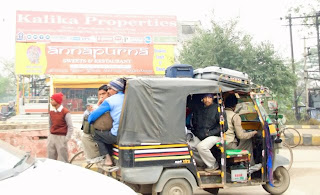Ideally, I would have loved to hike down to Agra, spend the day there, then head on over to Rajasthan to revel in the famed beauty of its palaces and opulent architecture.
Pity I didn't have enough time to do that this round. Next time for sure.
Instead, I hired a driver, and took the almost 5 hour ride from Delhi to Agra in the pursuit of this beautiful white marbled mausoleum, a symbol of love that has lasted since the 17th century.
I'm surprised I didn't go cranky just talking to myself considering I spent practically 10 hours (to and fro) in a car without company save for my very kind driver. Thank goodness I had a guide to entertain me during the 4 hours or so that I spent in Agra.
But it was worth every second of butt-soreness in the long car ride.
The anticipation started to build up the moment the we drove into Agra. Tourists and buses and guides and drivers filled every nook and cranny of an otherwise sleepy little city.
Vehicles could only drive up to a certain point in front of the Taj grounds before tourists had to disembark and switch to electric trams to take them up to the front gates of the Taj. This is to to prevent vehicle pollution from causing further damage to the Taj - which in itself takes an entire army to restore and maintain.
We entered from the North Gate - in itself an architectural wonder - and as I was marvelling at the red stone structure, I turned around and was suddenly awe-struck by the white dome a distance away that I had especially come to see.
 |
| North Gate entrance to the Taj Mahal |
Everyone knows that emperor Shah Jahan, mourning the death of his beloved wife, Mumtaz (who died during childbirth of their FOURTEENTH child), commissioned the building of this tomb in honour of his wife.
But did you know that the Taj Mahal and the surrounding grounds were designed in perfect symmetry and in an octagonal shape, mirroring the Islamic concept of heaven? And the mausoleum - with the sarcophagi of Shah Jahan and Mumtaz in the middle - sits right smack in the centre of the entire octagon. Right in the centre of heaven.
Did you also know that the Pakistani architect, commonly known as Lahauri (incidentally also from Lahore!), designed wells underneath the pillars of the Taj to act as shock absorbers for any earthquake tremors to prevent the Taj from collapsing?
And look closely at the 4 minarets guarding the dome - they're not ramrod straight. They're all slightly leaning outwards, away from the dome - another architectural spark by Lahauri to ensure that if the minarets ever fell prey to an earthquake, they would collapse away from the tomb and not onto it, thereby protecting the precious dome.
Amazing, really.



























